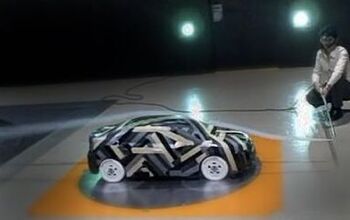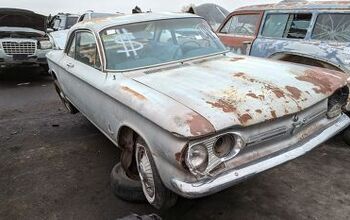In Defense of: The Chevrolet Corvair

Fifty years ago, GM’s engineers and designers worked overtime to create a radical new economy or “compact” car. Its mission: take on the VW Beetle and a host of European imports flooding the U.S. market. The 1960 Chevrolet Corvair flopped in its intended role. Nevertheless, it went on to become one of the single most influential American cars ever made. Its legacy can still be seen around the world.
The Chevrolet Corvair was a space efficient, low-slung compact with a six-cylinder air-cooled engine. The rear engine promised a low center of gravity, light unassisted steering, superb traction and balanced braking– all the same qualities that Porsche had been cultivating successfully for years. Budget-minded American driving enthusiasts were thrilled.
Unfortunately, the design came with intrinsic liabilities: poor heating, a complex (read: expensive) alloy engine, oil leaks and distinctly un-American handling qualities (read: oversteer). It was the last quality that attracted the attention of a consumer crusader named Ralph Nader, who highlighted the Corvair in his seminal tome “Unsafe at any speed.”
The Corvair was not intrinsically unsafe. As long as owners maintained the eleven pound differential between its front (15/19lbs) and rear (26/30lbs) tires, the Corvair’s handling remained friendly and innocuous. But Americans were (and are) not known for monitoring their vehicle’s tire pressure. Gas station attendants of the time had a mantra: “24 pounds all around.” They became unwitting co-conspirators in the Corvair’s fall (spin) from grace.
With incorrect tire pressures, a rapidly cornering Corvair driver could easily find the vehicle’s back end heading towards the front. The average US driver was simply not prepared to handle that eventuality. Could GM have done more to avoid the oversteer stigma? Yes. GM saved six dollars per car by not making the front anti-sway bar standard. And who knows how much (little) the effective rear camber-compensating spring adopted in 1964 cost.
In 1972, the National Highway Traffic Safety Administration issued a report exonerating the Corvair from Nader’s accusations. It arrived too late. Chevrolet had deep-sixed the Corvair seven years earlier. Even without the safety controversy, Chevy knew Ford’s highly conventional Falcon was about to eat their lunch. What’s more, GM’s beancounters had proclaimed that the Corvair was too expensive to make profitably (setting a pattern for small car thinking that continues to this day).
In the fall of 1959, Chevrolet was already cooking up Plan B: the 1962 Chevy II. Utterly conventional (and boring), the bigger Nova was the real anti-Falcon, and the route to compact-car profits. Which left a question: what to do with the Corvair?
The answer was the Corvair’s enduring U.S. legacy: the sporty Monza coupe. The model debuted at the 1960 New York Auto Show, complete with bucket seats, a higher output engine and a four-speed manual transmission. The Monza was an unexpected home run. In 1960, Chevy hastily assembled 14k Monzas. By 1961, the Monza dominated the Corvair line-up, and single-handedly created the market for popular-priced American-made performance cars.
But creating a market is not the same as exploiting it. Lee Iacocca’s seminal Mustang did that. Turbocharging and quad-carb induction couldn’t overcome the little six’s limitations against cheap V8 power. The Chevrolet Camaro was quickly pressed into action.
Meanwhile, the clean, elegant and highly-original 1960 Corvair initiated a styling revolution. In fact, it would be difficult to overstate the Corvair’s impact on European automotive design. Before the Monza, Europe was overdue for a new design lexicon. Even the conceptually-revolutionary 1959 Mini still wore the styling language of the early/mid fifties. The Corvair’s influence on subsequent European small and mid-size cars was unrivaled and unprecedented.
Some were blatant rip-offs: the NSU Prinz/1000, Hillman/Sunbeam Imp, Simca 1000, ZAZ-966, Panhard Dyna Coupe. Others were merely profoundly influenced: Fiat 1500, Lancia Fulvia, VW 1600 L Coupe (“the German Monza”) and a host of other early-mid sixties cars around the globe.
Yes, most of these models were narrower and taller than the Corvair. But the Corvair’s strong, high belt-line crease, its clean and inward curving lower flanks, airy green-house, under-cut front and strong rectilinear lines make its influence easily identifiable– even today.
Take a look a BMW 5-Series. That strong horizontal crease-line running unbroken from front to rear has long been BMW DNA, but it’s a genetic transplant from the Corvair. BMW’s renaissance (and styling DNA) is based on their mid-sixties sedans and coupes, including the popular 2002. Their design elements scream “Corvair”.
The timelessly elegant, superb handling 1965 Chevrolet Corvair was built past the Camaro’s 1967 intro– just so General Motors would not be seen to be buckling-in to Nader and other detractors. But tightening emission and safety standards had sealed its fate; the Corvair died a quiet death in 1969.
Mustangs, Camaros, BMW’s. Not a bad legacy, for such a star-crossed little car.

More by Paul Niedermeyer
Latest Car Reviews
Read moreLatest Product Reviews
Read moreRecent Comments
- El scotto They should be supping with a very, very long spoon.
- El scotto [list=1][*]Please make an EV that's not butt-ugly. Not Jaguar gorgeous but Buick handsome will do.[/*][*] For all the golf cart dudes: A Tesla S in Plaid mode will be the fastest ride you'll ever take.[/*][*]We have actual EV owners posting on here. Just calmly stated facts and real world experience. This always seems to bring out those who would argue math.[/*][/list=1]For some people an EV will never do, too far out in the country, taking trips where an EV will need recharged, etc. If you own a home and can charge overnight an EV makes perfect sense. You're refueling while you're sleeping.My condo association is allowing owners to install chargers. You have to pay all of the owners of the parking spaces the new electric service will cross. Suggested fee is 100$ and the one getting a charger pays all the legal and filing fees. I held out for a bottle of 30 year old single malt.Perhaps high end apartments will feature reserved parking spaces with chargers in the future. Until then non home owners are relying on public charge and one of my neighbors is in IT and he charges at work. It's call a perk.I don't see company owned delivery vehicles that are EV's. The USPS and the smiley boxes should be the 1st to do this. Nor are any of our mega car dealerships doing this and but of course advertising this fact.I think a great many of the EV haters haven't came to the self-actualization that no one really cares what you drive. I can respect and appreciate what you drive but if I was pushed to answer, no I really don't care what you drive. Before everyone goes into umbrage over my last sentence, I still like cars. Especially yours.I have heated tiles in my bathroom and my kitchen. The two places you're most likely to be barefoot. An EV may fall into to the one less thing to mess with for many people.Macallan for those who were wondering.
- EBFlex The way things look in the next 5-10 years no. There are no breakthroughs in battery technology coming, the charging infrastructure is essentially nonexistent, and the price of entry is still way too high.As soon as an EV can meet the bar set by ICE in range, refueling times, and price it will take off.
- Jalop1991 Way to bury the lead. "Toyota to offer two EVs in the states"!
- Jalop1991 I'm sorry, Dave. I'm afraid I can't do that.







































Comments
Join the conversation
Great article. Corvair has always been near the top of my list of best looking cars. Effortlessly elegant. Interesting to learn that it was officially imported into Europe. I've always thought that of all the Detroit cars of the era, the Corvair was the one that would appeal the most to us Euros. @DarkOneForce: As I recall, the ADO16 (Austin/Morris 1100/1300) was styled by Pininfarina? I think the Mini was an Issigonis job though.
I miss my 1961 Corvair Coupe ~ it was a base model , not even a radio although it had the two speed Slip 'N Slide Powerglide transaxle . It's engine was totally worn out but never leaked any oil after I replaced the crappy seals with Viton ones . You had to drive a Corvair to appreciate it's good handling and fun drivability . -Nate